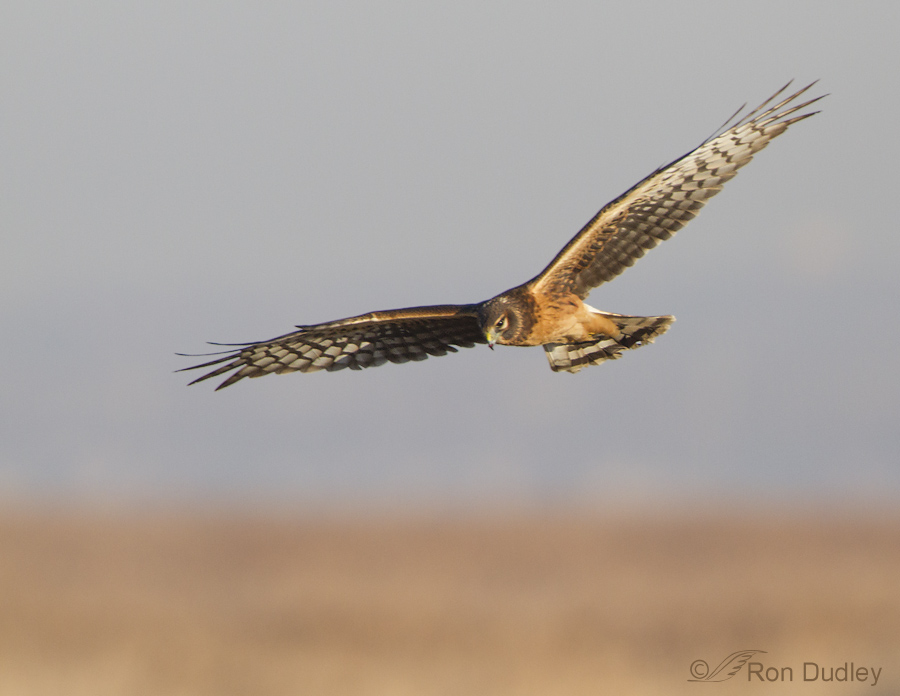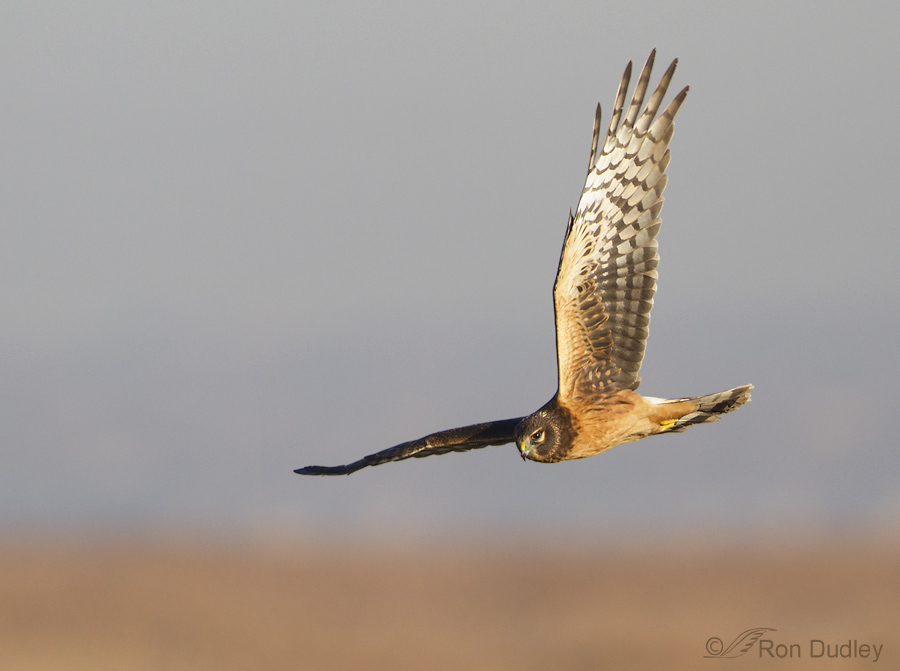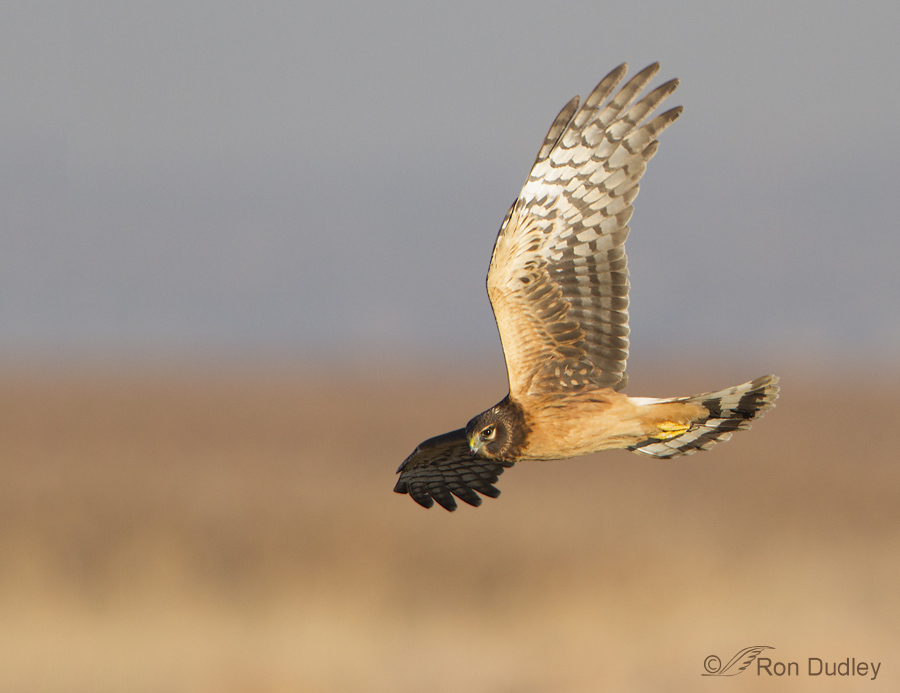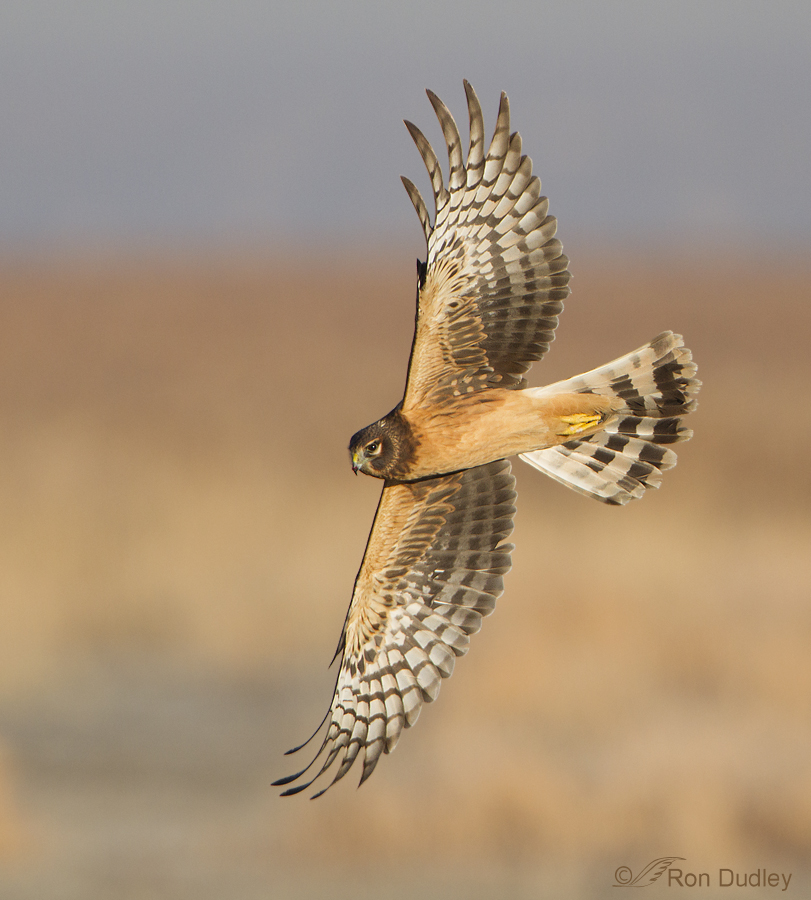Eight days ago I photographed a Northern Harrier as it flew toward me at an angle and then banked away. The following day, because of time constraints and computer issues I posted only a single shot of the banking maneuver but now I wish I had posted the entire flight sequence of four images. With your indulgence for posting the same image twice I’ll do just that this morning.

1/2000, f/6.3, ISO 640, 500 f/4, 1.4 tc, not baited, set up or called in
Here, though the bird is very aware of my presence as it approaches it’s still looking down as it hunts below for voles. It’s a little too far away for good image quality and sharpness but I wanted to show the change in demeanor as it got closer to me.
1/2000, f/6.3, ISO 640, 500 f/4, 1.4 tc, not baited, set up or called in
Four frames later the harrier is close enough that it temporarily abandoned any thought of hunting and kept its eye on me instead (I’m definitely a suspicious looking guy…). Its left wing is raised in a gentle turn to its right.
1/2000, f/6.3, ISO 640, 500 f/4, 1.4 tc, not baited, set up or called in
Now the bird is flying almost parallel to me but still getting slightly closer, apparently a little too close for comfort so…
1/2000, f/6.3, ISO 640, 500 f/4, 1.4 tc, not baited, set up or called in
the bird quickly banked and flew at an angle away from me.
This banking maneuver is so quick that I was lucky to get it. The photographer’s best chance is to already be shooting a burst when it occurs, which is exactly what happened here. Because of the sudden change in direction and speed you just have to hope that you don’t cut off any body parts.
Ron





Beautiful, Ron…love the series.
Her change in focus seems to be more and more toward you, Ron, through the series of photos. She is stunning in that bank and a bit terrifying in the first one when hunting.
I’d like to learn more about those raptor eyes, Bill. Where can I find more online information to explain the horizontal scanning strip and the ability to see in both color and black and white at the same time?
Pam: I have quite an extensive library of books on raptors and made my living for many years teaching in various school systems and levels about them using many life, healthy models. I could list many of my books here but many are out of print. If you enjoy books seach used book stores.
This all started before the Internet but now days there is tons of information on the Internet. Wikipedia is a reasonable place to start but I strongly recommend researching from other sources as well. Unfortunately there is a great deal of misinformation out there and far too many generalizations on the subject of raptors which can result in confusion and further passing on of misinformation. The thing I love most about raptors is there extensive variety of behaviours, looks and adaptations, as well as all they teach us about our world.
So to address your question with regards to raptor eyes simply google that topic and read the various sources. You will likely find a great variety of info as well as quality of info. Part of knowing how to research info is knowing how to word your search and to dig well beyond the first page of sources. Often the best info is beyond the surface.
Bill
Well done!
Sensational Ron!
Charlotte
Thanks, Charlotte.
Are you sure it was suspicion? Given the clarity and beauty here I am wondering whether it was ‘just putting my best side forward’ for the well-known bird papparazzi?
I suspect it was well-deserved suspicion, Elephant’s Child. I’m pretty scary looking…
So are the raptors (but beautiful with it). It is all a question of perspective.
Outstanding sequence, Ron! Great suggestion from Diana. Bill’s information is, well, “illuminating”, to say the least!
Once again, your superb educational skills benefit an entire community of photographers, birders, scientists, nature lovers and folks who just plain look at the pictures ’cause they know what they like.
Wally, thanks so much for that last sentence especially. Means a lot!
Often I read about raptors “looking at me” in comments by many on various sites on the Internet. The raptor eye is probably the most evolved eye of any animal. Most have two plains of vision called foveas (a central and temporal) that are divided by a horizontal strip (used for scanning). Most also see in color (in a much greater spectrum than humans) and black and white (many mammals don’t have that capability). Because of the two fovea (in each eye) they can be looking at the ground AND outwardly (either somewhat level of upward) at the same time and their brains can process all this info. Even outside these foveas the raptors have about twice the acuity we have. The head bobbing often seen combined with their binocular vision allows them to build up a detailed stereoscopic image and a good perception of distance.
Once again a complex topic.
Bill
Really fascinating stuff, Bill. I was aware of some of it but most was new to me. Thank you once again!
Just wetting appitites. LOL There is so much more to their eyes that are different from any other animals. Density of the rods and cones, oil droplets on those cells, muscle functions. It all makes for their superlative vision.
Bill
WOW!!! So glad I subscribed to your site and get the daily emails linking your new posts. What a great way to start the day. 🙂 Thanks for your work and passion!
I’m glad you’re here too, Suze. Hope you enjoy!
Great shots!!!!!! And I love Harriers.
Don’t know how many times I can tell you and Mia how I love your photography, but it never gets old.
It never gets old hearing it either, Jerry… Thank you.
Great sequence of shots showing this amazing creature and all of its’ feathers!! I only wish I could get the clarity you get when shooting.
Believe me, Ellen – I don’t get this “clarity” in all my shots.
Ron, your last shot of the bird banking away shows all the feather groups so maybe I can finally learn them.. Thanks for my morning bird fix.
That’s something I should do too, Diana. I’ve put it off for much too long. I know them fairly well but not well enough…
Diana: Here is a diagram that may help with that. Raptor feather names can vary slightly depending on author and background and also vary in number depending on species:
http://i17.photobucket.com/albums/b64/smunster/Diagrams/5fb2db35-c023-4bf6-9bd6-1937906f9903.jpg
http://i17.photobucket.com/albums/b64/smunster/Diagrams/27092a7f-5bfc-4a34-863e-9c5b4a51fbf0.jpg
Bill
Very helpful drawings, Bill – particularly the first one. Thanks.